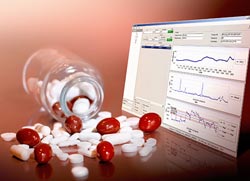Rapid and Reliable Pharmaceutical Production

<br>
By contrast to traditional batch methods of production, where medications are produced one step at a time, Sipat makes continuous production possible while incorporating constant quality control.
This method of production makes it possible to save up to 20 percent on costs and to cut production time from up to two months down to about ten days. Siemens will present the new version of Sipat at Achema, the world's largest chemical industry trade fair, which will be held in Frankfurt from June 18 to 22, 2012.
Manufacturing pharmaceuticals by means of batch production methods is time consuming, cost intensive, and uses a lot of energy. One batch or “charge” of products, such as tablets or capsules, moves through the production process as a unit. The raw material must be granulated, dried, pulverized, mixed, and pressed.
The process is repeatedly halted between steps so that samples can be taken. Only when it is certain that the product is completely homogenized or the active ingredient concentration has the necessary quality is the production process continued. As a result, production can take several weeks.
If the quality of the preliminary product is not up to standard, the charge is discarded. This manufacturing technique also does not make optimal use of the production facilities.
A continuous production process is less expensive, more efficient, and uses less raw materials and energy. The automation experts at Siemens have developed the Sipat software in collaboration with large pharmaceutical companies and plant manufacturers. It is the core of a continuous production system. Sipat continuously polls process data for information about moisture content, temperature, density or grain size distribution, etc.
By correlating this information, Sipat can predict the quality of any given tablet at any point in the process. If the data from the running production threatens to exceed tolerance limits, the process can be immediately adjusted. This real-time release makes it possible to achieve a production time of about ten days.
Apart from that, continuous production makes it possible to use production facilities much more efficiently. Plant manufacturers can simply integrate the newest version V4 of Sipat into their systems.
Media Contact
More Information:
http://www.siemens.com/innovationnewsAll latest news from the category: Life Sciences and Chemistry
Articles and reports from the Life Sciences and chemistry area deal with applied and basic research into modern biology, chemistry and human medicine.
Valuable information can be found on a range of life sciences fields including bacteriology, biochemistry, bionics, bioinformatics, biophysics, biotechnology, genetics, geobotany, human biology, marine biology, microbiology, molecular biology, cellular biology, zoology, bioinorganic chemistry, microchemistry and environmental chemistry.
Newest articles

Superradiant atoms could push the boundaries of how precisely time can be measured
Superradiant atoms can help us measure time more precisely than ever. In a new study, researchers from the University of Copenhagen present a new method for measuring the time interval,…

Ion thermoelectric conversion devices for near room temperature
The electrode sheet of the thermoelectric device consists of ionic hydrogel, which is sandwiched between the electrodes to form, and the Prussian blue on the electrode undergoes a redox reaction…

Zap Energy achieves 37-million-degree temperatures in a compact device
New publication reports record electron temperatures for a small-scale, sheared-flow-stabilized Z-pinch fusion device. In the nine decades since humans first produced fusion reactions, only a few fusion technologies have demonstrated…





















